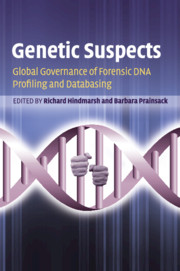Book contents
- Frontmatter
- Contents
- List of contributors
- About the contributors
- Foreword
- Acknowledgements
- 1 Introducing Genetic Suspects
- Section 1 Key areas in DNA profiling and databasing
- Section 2 National contexts of forensic DNA technologies and key issues
- 7 DNA databases and the forensic imaginary
- 8 Partners in crime: the use of forensic DNA technologies in Austria
- 9 Inquisitorial forensic DNA profiling in the Netherlands and the expansion of the forensic genetic body
- 10 DNA the Nor-way: black-boxing the evidence and monopolising the key
- 11 Portuguese forensic DNA database: political enthusiasm, public trust and probable issues in future practice
- 12 On trial! Governing forensic DNA technologies in the USA
- 13 Biosurveillance and biocivic concerns, from ‘truth’ to ‘trust’: the Australian forensic DNA terrain
- 14 Finding the balance: forensic DNA profiling in New Zealand
- 15 Forensic DNA profiling and databasing: the Philippine experience
- Section 3 Conclusions
- Index
- References
10 - DNA the Nor-way: black-boxing the evidence and monopolising the key
from Section 2 - National contexts of forensic DNA technologies and key issues
Published online by Cambridge University Press: 05 October 2012
- Frontmatter
- Contents
- List of contributors
- About the contributors
- Foreword
- Acknowledgements
- 1 Introducing Genetic Suspects
- Section 1 Key areas in DNA profiling and databasing
- Section 2 National contexts of forensic DNA technologies and key issues
- 7 DNA databases and the forensic imaginary
- 8 Partners in crime: the use of forensic DNA technologies in Austria
- 9 Inquisitorial forensic DNA profiling in the Netherlands and the expansion of the forensic genetic body
- 10 DNA the Nor-way: black-boxing the evidence and monopolising the key
- 11 Portuguese forensic DNA database: political enthusiasm, public trust and probable issues in future practice
- 12 On trial! Governing forensic DNA technologies in the USA
- 13 Biosurveillance and biocivic concerns, from ‘truth’ to ‘trust’: the Australian forensic DNA terrain
- 14 Finding the balance: forensic DNA profiling in New Zealand
- 15 Forensic DNA profiling and databasing: the Philippine experience
- Section 3 Conclusions
- Index
- References
Summary
INTRODUCTION
In July 2004, the Norwegian Government appointed the so-called Strandbakken Committee to consider changes in the laws regarding the forensic DNA database, which had become operational in 1999. In late 2005, exactly 10 years after it was first decided to establish a forensic DNA database in Norway, the committee submitted a White Paper to Parliament (Ministry of Justice and the Police 2005: 19). While the White Paper supported a substantial expansion of Norway's forensic DNA database, it also raised a number of issues about the use of DNA databases in criminal law administration. Approximately 35 stakeholders including government offices, other institutions and non-government organisation commented on the White Paper. These comments were collated in a proposition to the Odelsting (Odelstingsproposisjoner 19) (Ministry of Justice and the Police 2006), which served as an advisory document to Parliament.
Two years after the publication of the White Paper, in December 2007, the Norwegian Parliament ruled to expand the forensic DNA database and appropriated 64 million kroner (approximately €7 million) to finance this ‘DNA revolution’. According to Knut Storberget (2007), the Norwegian Minister of Justice, DNA analysis was an important tool in the battle against criminality, outperforming other forensic methods in efficiency and reliability by helping to free up police resources and raise detection rates for a variety of crimes, ranging from volume crime, serious crime and organised crime to national and international crime, which would lead to increased levels of security.
- Type
- Chapter
- Information
- Genetic SuspectsGlobal Governance of Forensic DNA Profiling and Databasing, pp. 197 - 217Publisher: Cambridge University PressPrint publication year: 2010
References
- 3
- Cited by



